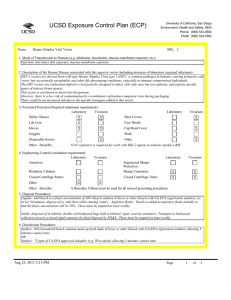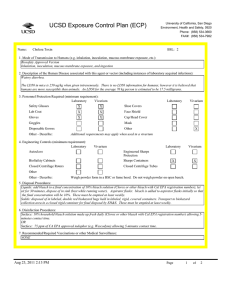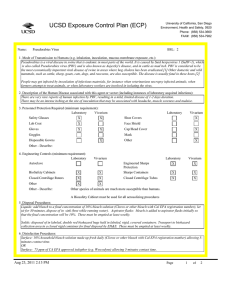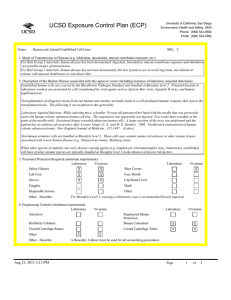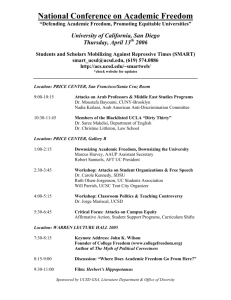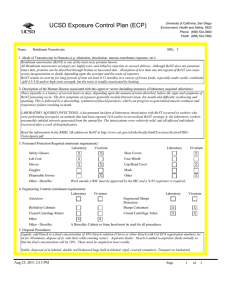UCSD Exposure Control Plan (ECP)
advertisement
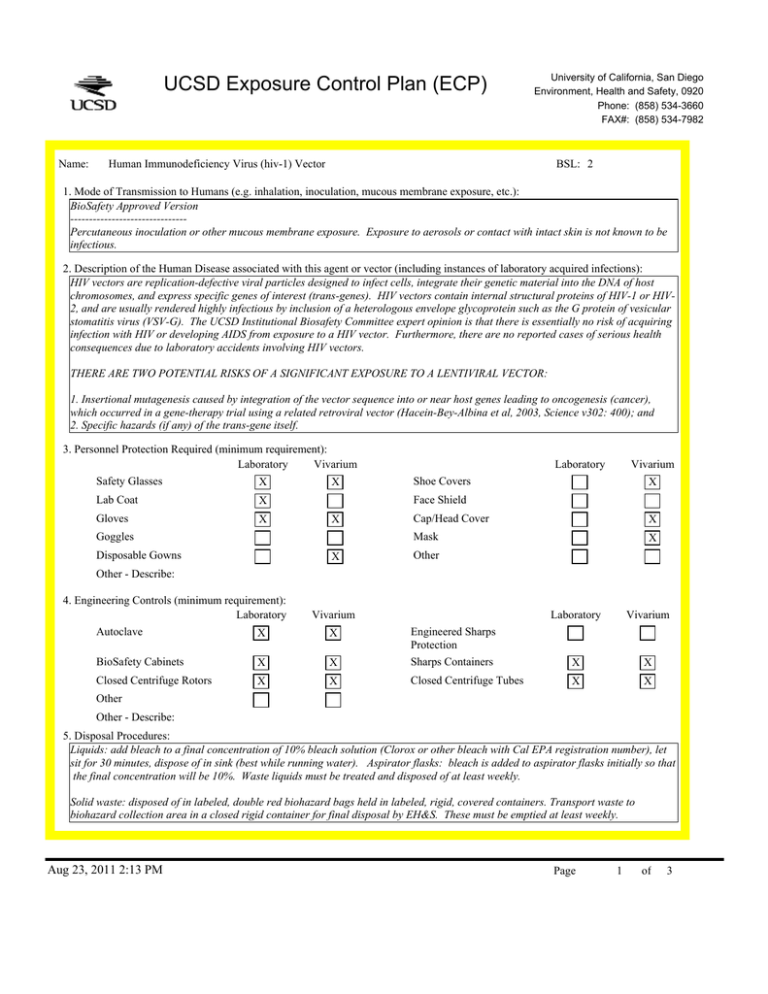
UCSD Exposure Control Plan (ECP) Name: University of California, San Diego Environment, Health and Safety, 0920 Phone: (858) 534-3660 FAX#: (858) 534-7982 Human Immunodeficiency Virus (hiv-1) Vector BSL: 2 1. Mode of Transmission to Humans (e.g. inhalation, inoculation, mucous membrane exposure, etc.): BioSafety Approved Version ------------------------------Percutaneous inoculation or other mucous membrane exposure. Exposure to aerosols or contact with intact skin is not known to be infectious. 2. Description of the Human Disease associated with this agent or vector (including instances of laboratory acquired infections): HIV vectors are replication-defective viral particles designed to infect cells, integrate their genetic material into the DNA of host chromosomes, and express specific genes of interest (trans-genes). HIV vectors contain internal structural proteins of HIV-1 or HIV2, and are usually rendered highly infectious by inclusion of a heterologous envelope glycoprotein such as the G protein of vesicular stomatitis virus (VSV-G). The UCSD Institutional Biosafety Committee expert opinion is that there is essentially no risk of acquiring infection with HIV or developing AIDS from exposure to a HIV vector. Furthermore, there are no reported cases of serious health consequences due to laboratory accidents involving HIV vectors. THERE ARE TWO POTENTIAL RISKS OF A SIGNIFICANT EXPOSURE TO A LENTIVIRAL VECTOR: 1. Insertional mutagenesis caused by integration of the vector sequence into or near host genes leading to oncogenesis (cancer), which occurred in a gene-therapy trial using a related retroviral vector (Hacein-Bey-Albina et al, 2003, Science v302: 400); and 2. Specific hazards (if any) of the trans-gene itself. 3. Personnel Protection Required (minimum requirement): Laboratory Vivarium Safety Glasses X X Lab Coat X Gloves X Vivarium X Face Shield X Goggles Disposable Gowns Laboratory Shoe Covers X Cap/Head Cover X Mask X Other Other - Describe: 4. Engineering Controls (minimum requirement): Laboratory Autoclave X Vivarium BioSafety Cabinets X X Engineered Sharps Protection Sharps Containers Closed Centrifuge Rotors X X Closed Centrifuge Tubes X Laboratory Vivarium X X X X Other Other - Describe: 5. Disposal Procedures: Liquids: add bleach to a final concentration of 10% bleach solution (Clorox or other bleach with Cal EPA registration number), let sit for 30 minutes, dispose of in sink (best while running water). Aspirator flasks: bleach is added to aspirator flasks initially so that the final concentration will be 10%. Waste liquids must be treated and disposed of at least weekly. Solid waste: disposed of in labeled, double red biohazard bags held in labeled, rigid, covered containers. Transport waste to biohazard collection area in a closed rigid container for final disposal by EH&S. These must be emptied at least weekly. Aug 23, 2011 2:13 PM Page 1 of 3 UCSD Exposure Control Plan (ECP) 6. Disinfection Procedures: Surface: 10% household bleach solution made up fresh daily (Clorox or other bleach with Cal EPA registration number) allowing 5minutes contact time. OR Surface: 75 ppm of CA EPA approved iodophor (e.g. Wescodyne) allowing 5-minutes contact time. OR Surface: 70% ethanol for wipe down of surfaces allowing 5-minutes contact time. 7. Recommended/Required Vaccinations or other Medical Surveillance: None 8. Employee Exposures- first aid procedures: Immediate and extensive washing with soap and water. a. Eye exposure from splash or aerosols - rinse a minimum of 15 minutes in eye wash or flush area with water. b. Needle stick and/or sharps exposure - wash wound area with soap and water for 15 minutes c. Skin exposure - wash area with soap and water for 15 minutes d. Contamination of clothing - remove the contaminated clothing and place in biohazard bag, shower with the emergency douse shower, and put on clean clothes. e. Spill or release - Monday through Friday, 8a - 4:30p call EH&S (858-534-3660); after hours call UCSD Police (858-534-4357) 9. Employee Exposure - seek medical follow-up from the following medical providers: (TAKE THIS ECP WITH YOU) 24-hour walk-in service: Thornton Hospital Emergency Room (858) 657-7600 UCSD Medical Center (Hillcrest) Emergency Room (619) 543-6400 UCSD Employee: UCSD employee researchers should go to the nearest hospital and explain the following: The UCSD Institutional Biosafety Committee recommends that the exposed individual be counseled regarding the potential risks (see above), then offered a single-dose of anti-retroviral medication to prevent reverse transcription of the vector genetic material; specifically: one pill by mouth of Truvada (a combination medication containing tenofovir-300 mg and emtricitabine-200 mg). If indicated, medical prophylaxis should be administered as soon as possible, and no later than 24 hours after the exposure. There is no indication for continued therapy after the initial, single dose, because the HIV vector is not able to replicate. Contraindications include known hypersensitivity to Truvada or its components and/or renal failure. For patients with renal insufficiency or pregnancy (category B), the risks of prophylaxis with Truvada may outweigh the benefits. Side effects of Truvada include nausea, diarrhea, and dizziness. Non-UCSD Employee: Researcher should go to the nearest hospital in accordance with their health insurance provider. The UCSD Institutional Biosafety Committee recommends that the exposed individual be counseled regarding the potential risks (see above), then offered a single-dose of anti-retroviral medication to prevent reverse transcription of the vector genetic material; specifically: one pill by mouth of Truvada (a combination medication containing tenofovir-300 mg and emtricitabine-200 mg). If indicated, medical prophylaxis should be administered as soon as possible, and no later than 24 hours after the exposure. There is no indication for continued therapy after the initial, single dose, because the HIV vector is not able to replicate. Contraindications include known hypersensitivity to Truvada or its components and/or renal failure. For patients with renal insufficiency or pregnancy (category B), the risks of prophylaxis with Truvada may outweigh the benefits. Side effects of Truvada include nausea, diarrhea, and dizziness. For medical follow-up if required: Monday - Friday, 8a - 4:30p: UCSD Occupational & Environmental Medicine (619) 471-9210 10. Report All Injuries, Illnesses, and Exposures to EH&S: Complete the information found on What to Do if a Work-Related Injury, Illness, or Exposure Occurs (http://blink.ucsd.edu/Blink/ External/Topics/How_To/0,1260,4295,00.html) 11. Required Biosafety Training: 1) Laboratory specific training on hazards, exposure evaluations, and the required precautions for experimental procedures used with this agent - provided by the Principal Investigator. 2) All those working with HIV vector must have EH&S Viral Vector training. Aug 23, 2011 2:13 PM Page 2 of 3 UCSD Exposure Control Plan (ECP) 3) All users of this virus must read and understand this ECP 12. Lab specific instructions: Procedure listed in protocol S02174R. Biohazard sign required, cage card lists hazardous agent, protective equipment (latex gloves, mask (N95), disposable lab coat, goggles, hair net, footcovers, etc.), use of biological safety cabinet, and proper disposal of contaminated tools and equipment used. Aug 23, 2011 2:13 PM Page 3 of 3
